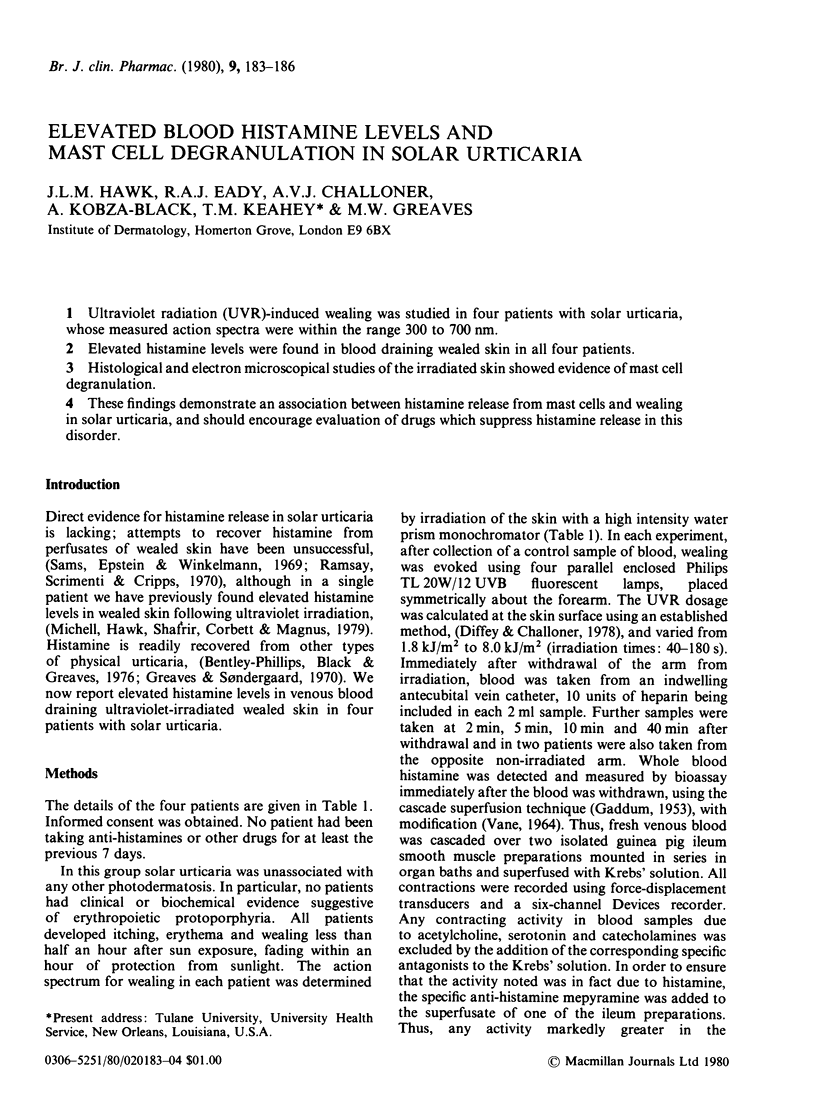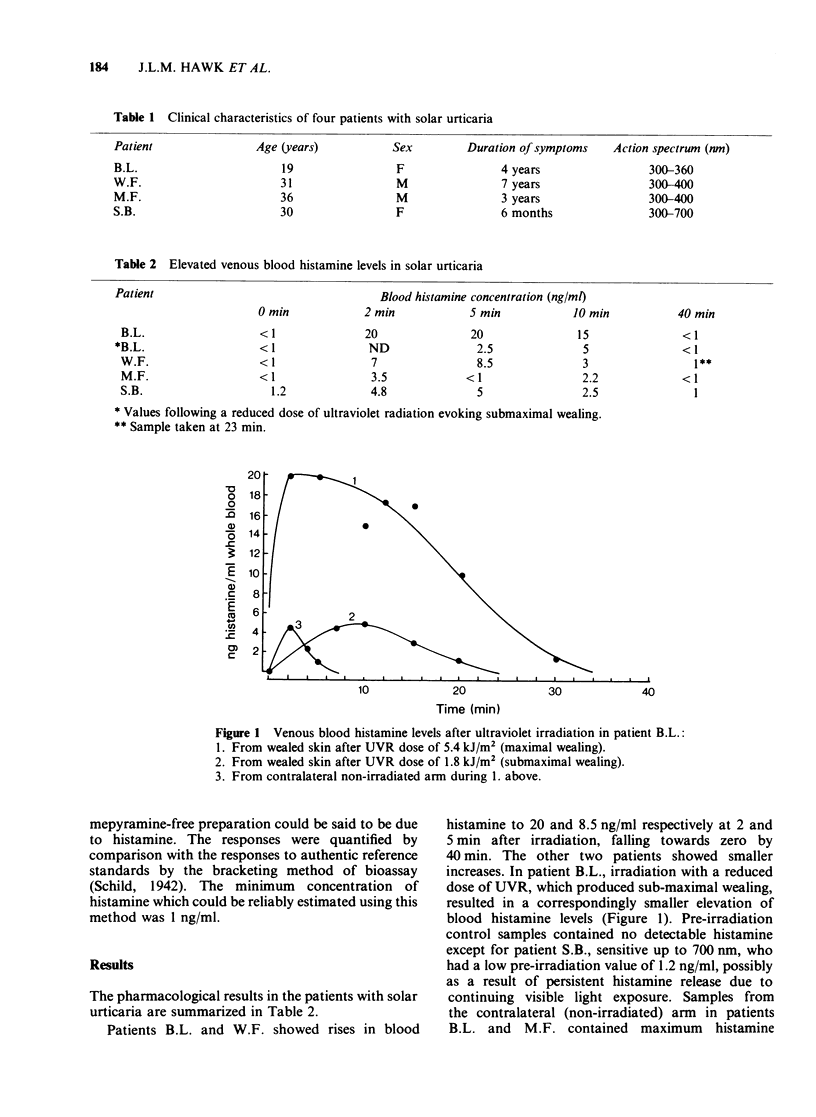Abstract
1 Ultraviolet radiation (UVR)-induced wealing was studied in four patients with solar urticaria, whose measured action spectra were within the range 300 to 700 nm. 2 Elevated histamine levels were found in blood draining wealed skin in all four patients. 3 Histological and electron microscopial studies of the irradiated skin showed evidence of mast cell degranulation. 4 These findings demonstrate an association between histamine release from mast cells and wealing in solar urticaria, and should encourage evaluation of drugs which suppress histamine release in this disorder.
Full text
PDF



Images in this article
Selected References
These references are in PubMed. This may not be the complete list of references from this article.
- Baart de la Faille H., Rottier P. B., Baart de la Faille-Kuyper E. H. Solar urticaria. A case with possible increase of skin mast cells. Br J Dermatol. 1975 Jan;92(1):101–107. doi: 10.1159/000144432. [DOI] [PubMed] [Google Scholar]
- Bentley-Phillips C. B., Black A. K., Greaves M. W. Induced tolerance in cold urticaria caused by cold-evoked histamine release. Lancet. 1976 Jul 10;2(7976):63–66. doi: 10.1016/s0140-6736(76)92285-6. [DOI] [PubMed] [Google Scholar]
- Bentley-Phillips C. B., Eady R. A., Greaves M. W. Cold urticaria: inhibition of cold-induced histamine release by doxantrazole. J Invest Dermatol. 1978 Oct;71(4):266–268. doi: 10.1111/1523-1747.ep12515101. [DOI] [PubMed] [Google Scholar]
- Diffey B. L., Challoner A. V. Absolute radiation dosimetry in photochemotherapy. Phys Med Biol. 1978 Nov;23(6):1124–1129. doi: 10.1088/0031-9155/23/6/008. [DOI] [PubMed] [Google Scholar]
- GADDUM J. H. The technique of superfusion. Br J Pharmacol Chemother. 1953 Sep;8(3):321–326. doi: 10.1111/j.1476-5381.1953.tb00801.x. [DOI] [PMC free article] [PubMed] [Google Scholar]
- Greaves M. W., Sondergaard J. Urticaria pigmentosa and factitious urticaria. Direct evidence for release of histamine and other smooth muscle-contracting agents in dermographic skin. Arch Dermatol. 1970 Apr;101(4):418–425. doi: 10.1001/archderm.101.4.418. [DOI] [PubMed] [Google Scholar]
- Huber J. D., Parker F., Odland G. F. A basic fuchsin and alkalinized methylene blue rapid stain for epoxy-embedded tissue. Stain Technol. 1968 Mar;43(2):83–87. doi: 10.3109/10520296809115048. [DOI] [PubMed] [Google Scholar]
- IVE H., LLOYD J., MAGNUS I. A. ACTION SPECTRA IN IDIOPATHIC SOLAR URTICARIA. A STUDY OF 17 CASES WITH A MONOCHROMATOR. Br J Dermatol. 1965 May;77:229–243. doi: 10.1111/j.1365-2133.1965.tb14637.x. [DOI] [PubMed] [Google Scholar]
- Ramsay C. A., Scrimenti R. J., Cripps D. J. Ultraviolet and visible action spectrum in a case of solar urticaria. Arch Dermatol. 1970 May;101(5):520–523. [PubMed] [Google Scholar]
- Röhlich P., Anderson P., Uvnäs B. Electron microscope observations on compounds 48-80-induced degranulation in rat mast cells. Evidence for sequential exocytosis of storage granules. J Cell Biol. 1971 Nov;51(21):465–483. doi: 10.1083/jcb.51.2.465. [DOI] [PMC free article] [PubMed] [Google Scholar]
- Sams W. M., Jr, Epstein J. H., Winkelmann R. K. Solar urticaria. Investigation of pathogenetic mechanisms. Arch Dermatol. 1969 Apr;99(4):390–397. doi: 10.1001/archderm.99.4.390. [DOI] [PubMed] [Google Scholar]
- Schild H. O. A method of conducting a biological assay on a preparation giving repeated graded responses illustrated by the estimation of histamine. J Physiol. 1942 Jun 2;101(1):115–130. doi: 10.1113/jphysiol.1942.sp003970. [DOI] [PMC free article] [PubMed] [Google Scholar]
- VANE J. R. THE USE OF ISOLATED ORGANS FOR DETECTING ACTIVE SUBSTANCES IN THE CIRCULATING BLOOD. Br J Pharmacol Chemother. 1964 Oct;23:360–373. doi: 10.1111/j.1476-5381.1964.tb01592.x. [DOI] [PMC free article] [PubMed] [Google Scholar]



